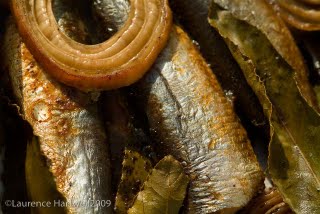Marios or in Cornish, 'Hern Ys Aysel'
 A great favourite around the pilchard (sardine) catching communities of Cornwall is the dish known simply as marios - marinaded pilchards. Just like the pasty, every fishing family's mum, grandmother and great-grandmother has their own 'unique' recipes - all based around headed and gutted pilchards, vinegar, cold tea, thinly sliced onions, salt and pepper, brown sugar, fresh bay leaves and, of course, a secret blend of pickling spices.
A great favourite around the pilchard (sardine) catching communities of Cornwall is the dish known simply as marios - marinaded pilchards. Just like the pasty, every fishing family's mum, grandmother and great-grandmother has their own 'unique' recipes - all based around headed and gutted pilchards, vinegar, cold tea, thinly sliced onions, salt and pepper, brown sugar, fresh bay leaves and, of course, a secret blend of pickling spices.If you don't know yourself, a blend of the appropriate pickling spices can be bought - if you know which - from a small chemist's shop over in St Ives. The methods vary, but essentially the gutted and headed fish are laid in a dish, the tea and sufficient wine vinegar (definitely not malt) added to cover along with the other ingredients to suit your personal taste. Most recipes call for the fish to be cooked overnight (the sort of thing range ovens of old or today's Agas are ideally suited) at a low temperature (60º) or, alternately, baked in a conventional oven at a high heat (150ºC) for 40 minutes and then left to cool for 24 hours. This will ensure that the bones almost dissolve and can be safely eaten.
Trouble is, the weather of late seems to have pushed the sardine shoals well offshore!
Here's another version sent in from St Ives ex-fisherman Billy Bunn - who can these days be found earning a living as skipper of the oil standby vessel, Putford Provider and tracked using AISlive - she berthed in Great yarmouth at 1am this morning.
"I headed, tailed, gutted and sniped off all the fins, put bay leaves in the bottom of a large deep pan, a little bit of salt, a few pinches of the spice, put some spice in the belly of each pilchard and a bay leaf - lay them in the dish - sprinkle some spice over and some leaves - repeat with another layer of pilchards then finish off with some leavess and spice - cover with malt vinegar - either put on a lid or brown paper - cook on a low heat overnight and test in the morning, the bones should be soft - to lesson the strength of the vinigar if you want add a little bit of water."

0 Comments:
Post a Comment
<< Home